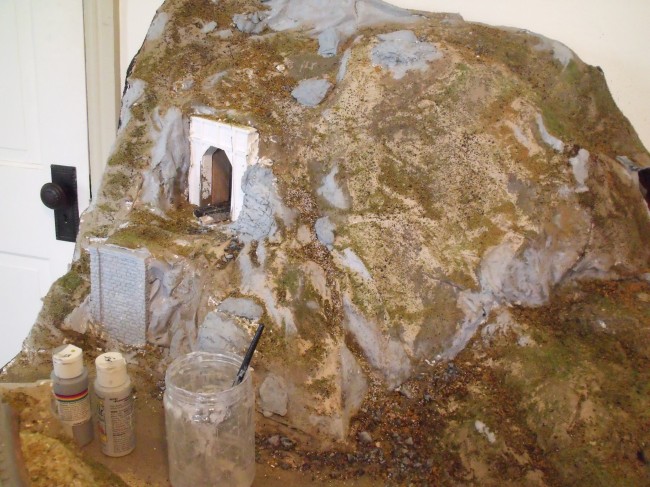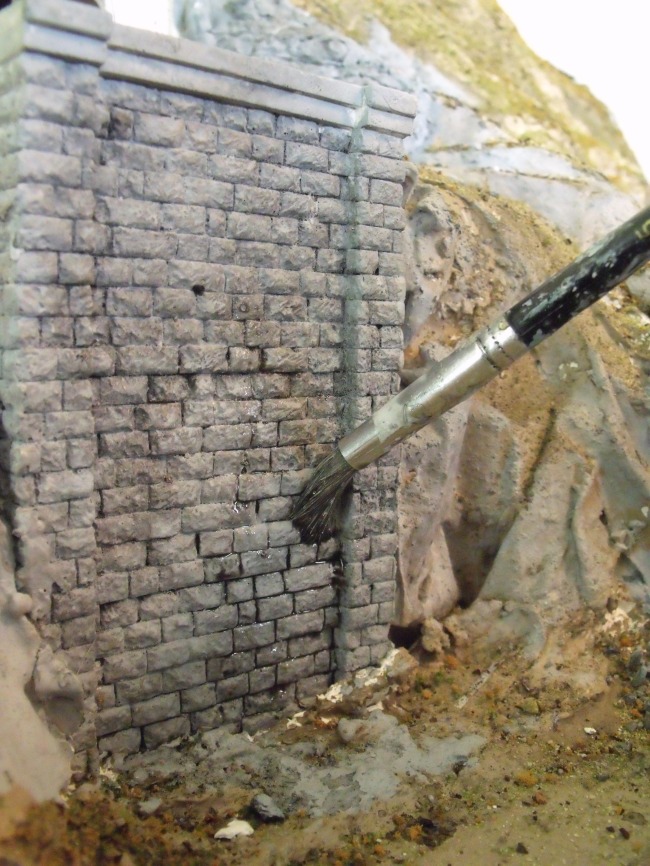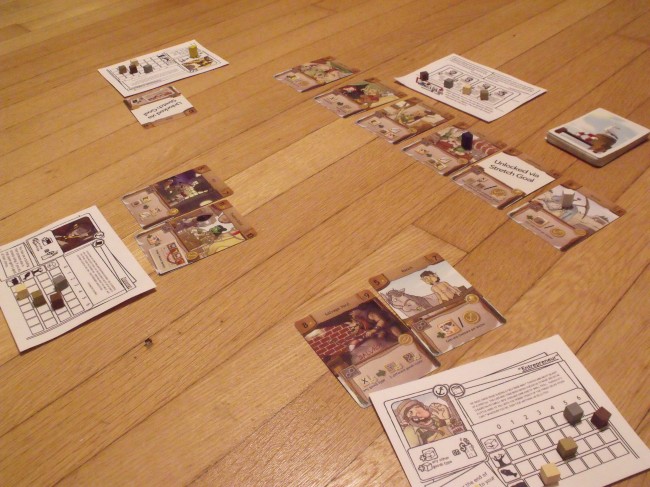As I alluded to in the previous game review, micro games are quickly becoming a big thing (in a somewhat ironic way) in the gaming world. Personally, I am all for it. For those of us with young children, we may not have a lot of time to squeeze in a big, heavy Euro game (though I will certainly try when I can), and we may not want to have all those many, little pieces to be lost, and inevitably found by the baby vacuum.
But, we still have that itch to play a game, especially one with some meat to it, that engages your mind and gives you a feel for conquering, or building, or scheming, etc. (Sorry Uno- you just don’t make the cut!) On the same hand, we don’t have the time, or the energy (or both) to play Puerto Rico, 7 Wonders, Caylus, etc. Enter the micro game. The best ones boil down all those components and mechanics into a much simpler, quicker, smaller package.
While definitions of micro games are varied, sooner or later, you will find the standard that Good Little Games (GLG) sets: 18 cards plus some pieces or dice. While it might seem a little arbitrary and gimmicky, these little games actually work well, and are worth a look.
Now, unlike games you can buy in the store, the games put out by GLG are Print and Play (PnP) meaning you print them out and make them yourself. For us crafty types, this is quite a deal! For a little bit of time and work, we can have a nice game that we didn’t have to buy (sort of).
However, if the idea of making a game seems formidable, have no fear. These games are simple to make. Just print out the sheets, mount them (or not), cut, and play!
“The Empire Engine”, designed by Chris Marling & Matthew Dunstan, is one such game put out by GLG, and is well worth your consideration. For the 20-30 minutes of time you put into the playing of it, this game offers a robust gaming experience, albeit somewhat abstractly.
OVERVIEW
The game is loosely set in a steampunk alternate history around the end of the 1800’s in a “dystopian alternate reality” with various factions vying for dominance. It is within this backdrop that you must build your empire to be the most powerful and most productive so that you can ultimately triumph! Now granted, this is a micro game, so there is no map here. In fact, there are no fancy cards for inventing, or monuments, or cities, or towns, factories etc? All you have are some gears and two engines?
Admittedly the game is somewhat abstract, and so thematically, the theme is not super in-depth. In essence, your engines represent the actions your empire can perform during your turn, and the gears are how you activate different actions. The Empire Engine uses a rondel mechanic, which is pretty amazing in my opinion as a budding game designer, to simulate a much large game with factories, production, armies and battle. And, it works well.
CONSTRUCTION
Since this is a PnP game, the assembly of the game should be considered in this review. As mentioned before, this game is a cinch to make. The rules can be printed double sided on a single sheet of printer paper (You can even do it in black and white to save space).
The cards themselves are on two sheets of paper. I personally prefer to use photo paper (matte or glossy) and mounting it on cardstock (like the card board that a cereal box is made of. Cheerios boxes are a great source for thick cardstock) for making a more tile like card. If you want more of a card-like card, you could print it on thick printable cardstock (available through any office supply store), or print it on regular paper and laminate it. Or if you just want to try it, print it on regular paper, cut, and play. (alternately, you could mount the cut paper cards on old playing cards for more weight and durability.)
The key here is to take your time and make it t the quality that you are happy with. I used photo paper mounted on cardstock simply because I like how it looks and feels. All the tools you would need to do this are below:
Simply print, then carefully glue the sheets to the cardstock. I use an old brush dipped in a little bit of water (not too much) to spread the glue around the entire back of the sheet. Once mounted, press the pages between a couple heavy books. (Dictionaries, theology textbooks, etc) After a day or so, you can carefully cut out the cards (I used a straight edge and a sharp knive) and you are ready to play… almost.
The cubes (you need 45) are really the only difficult part of the build. If you are thrify, you can either scavenge the pieces you need off of other games, or use beads, Legos, etc. I used counting cubes, which are great for making games with cubes: http://www.amazon.com/Learning-Resources-Centimeter-Cubes-LER2076/dp/B000QDTVFG/ref=sr_1_4?ie=UTF8&qid=1402533805&sr=8-4&keywords=counting+cubes
GAMEPLAY
The game progresses through a variable amount of rounds set by the number of players. During the round players simultaneously select the gears they want to use and use them to activate their engine, which spins the engine cards 0,1,2,or 3 quarter-turns to activate the desired action. Your goal is to have the most points at game end, and you get points by earning cubes to your score pile.
You can choose to invent, which sends one cube directly from the supply to your score pile. Or you can choose to arm (add soldiers) so that you can attack in the future and gain cubes for your score pile that way (if you successfully attack) You can choose to produce goods which can be used to pay for changing your gears (the values available to you to use are 1 and 2, but by paying one resource (good or soldier) you can access the alternate values, 0 and 3.) If you are not attacked, you can choose to export all the goods you currently have into your score pile. Lastly, you can choose to salvage (assuming you are not attacked) and you can gain one good of your choice to your score pile.
The tricky part to all this is that you must always rotate your engines each round. So the actions you took last term are different than this turn, and ideally, you should have set yourself for this turn from your actions last turn. There is a lot of bluffing and second guessing going on here. Do I choose to attack him, and hope he does not defend? Or should I assume that since he attacked me last round, I can safely export my goods this round?
The mechanics make for some interesting choices. You have to make some hard decisions, sometimes between more goods and soldiers for you to use next turn, or defending yourself so that your opponent can not steal a hard-earned good and take it away as plunder. Can you risk being defenseless so you can hopefully get a big jump in your score by exporting a lot of goods? These are all decisions you will find yourself making every round. Also, you find yourself evaluating your opponents. How badly does he need to export? Can I attempt an attack unawares and block him from scoring?

I pay one good to keep my one engine on “attack” while my other engine spins 2 quarter turns to “produce” 2 goods
This is not mean that the mechanics are difficult to understand or that the game is hard to play. Rather, the game benefits from a fairly simple mechanic. Plus, because of your limited options before you, based on your last actions, it can be a relatively quick game, even with those who are slightly prone to analysis paralysis. However, to be able to master the game and optimize your little empire-building engine, it takes some time and careful thought. In short, it is relatively easy to learn, but will take a long time to master- there is plenty going on to keep you busy.
FINAL THOUGHTS
Needless to say, the first game you play might seem a little confusing and overwhelming, simply because there is a lot going on in such a little game. The nuances of the optimal strategies are not usually apparent. This game rewards those who think ahead, and can ‘get into their opponents’ heads. Especially in a two player game, it can become a battle of wits to see who will outmaneuver whom.
But, this game is a lot of fun to play as well. For those who like to think in their game, and like to feel the game is reasonably in their control, with little chance involved, this game fits the bill. It is easy to craft for yourself, and it is relatively simple to play.
If you are not a fan of thinking games, this game is probably not for you. But for those who consider themselves gamers, this game has a lot to offer. It makes a great filler, or for those of us with a little less time; can make an enjoyable evening with plenty of thinking and strategy, in a short, sweet package.
If you want a copy, simply download it here: http://www.goodlittlegames.co.uk/games/08-the-empire-engine.html
Or, if Steampunk isn’t your thing, there is a beautiful sci-fi redesign than is worth looking at: https://yadi.sk/d/W6LZZagyLkSta
















